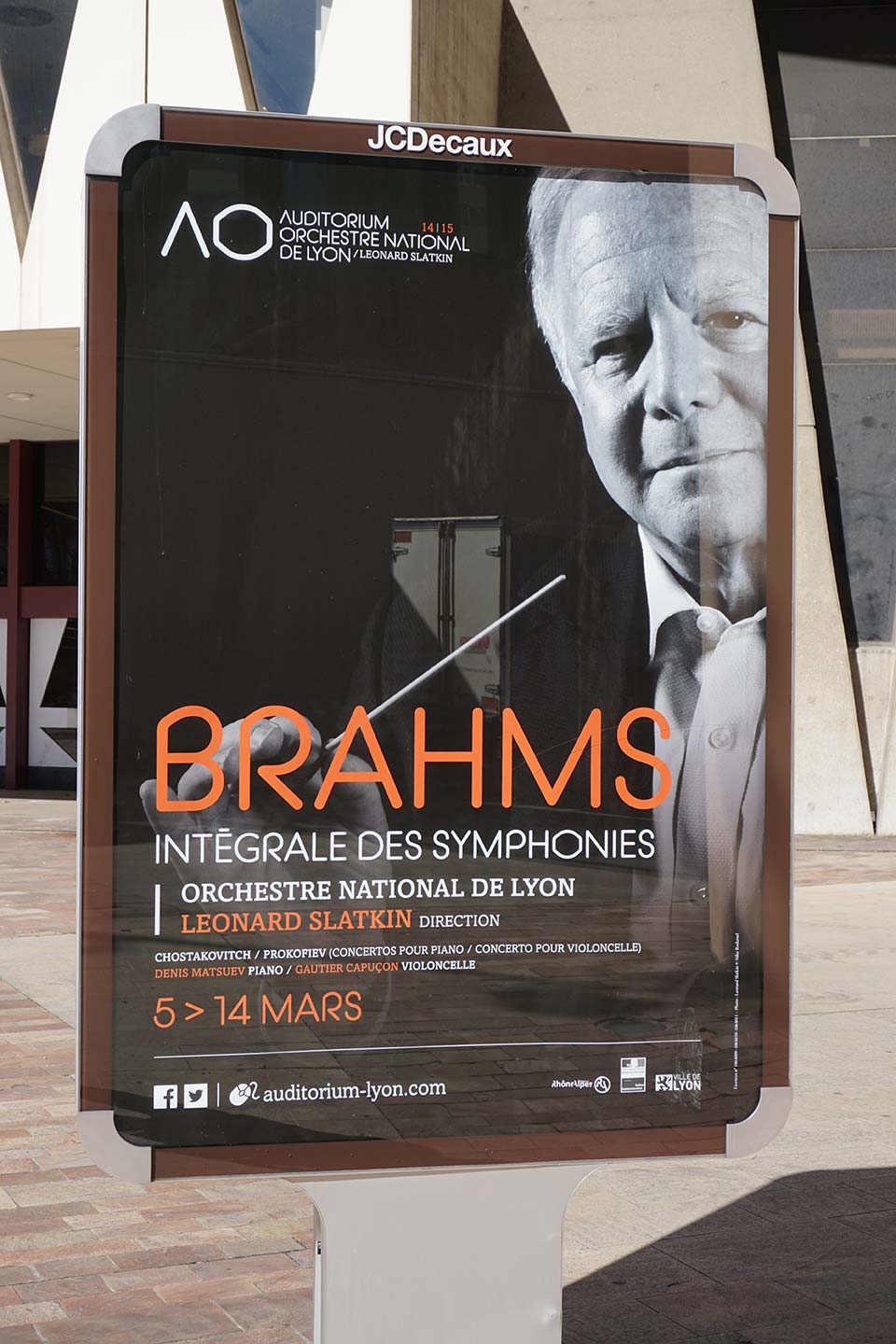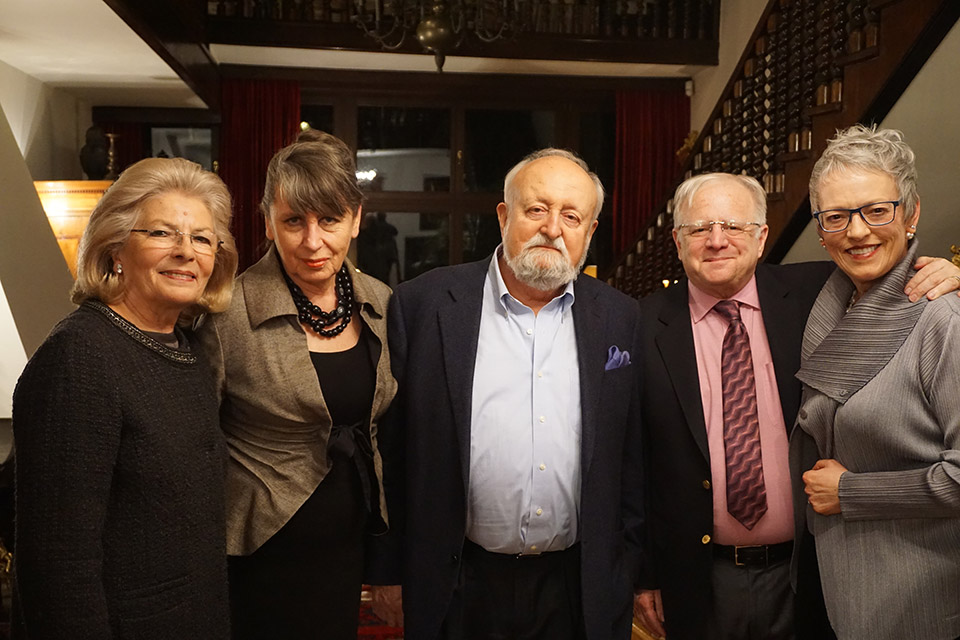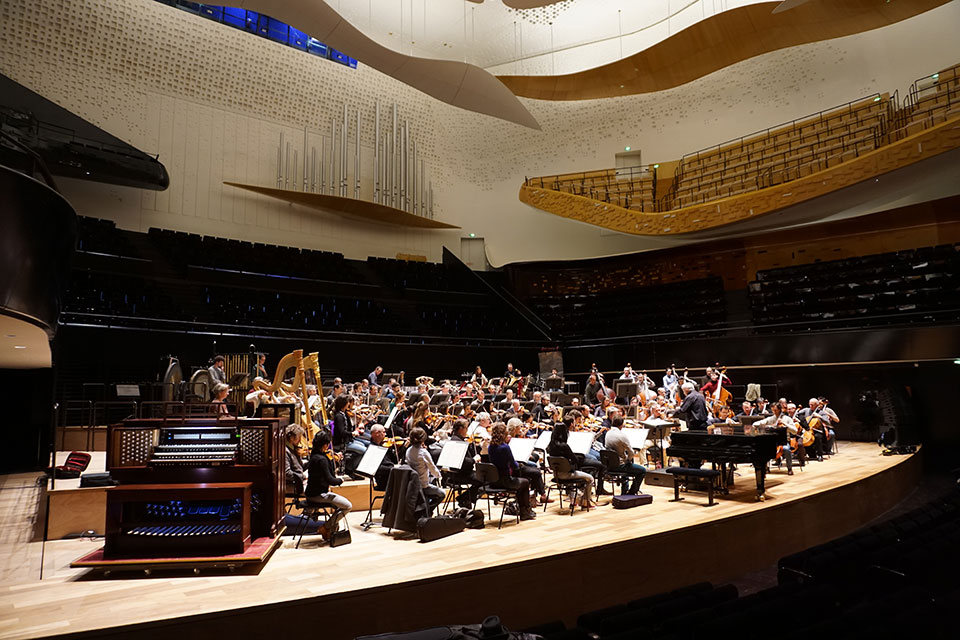If the frying pan, fire analogy ever existed, it certainly applied to the first part of March. Having successfully navigated my way through the six Tchaikovsky symphonies in three weeks, it was back to Lyon for the four by Brahms over a two-week period. Even though these works are regular repertoire, two of them were first meetings between the ONL and me.
The idea for this mini-festival was to focus on three elements for each concert. The symphonies were played in chronological order, something we could not do with Tchaikovsky in Detroit. But rather than an all-Brahms program, each concert also included a Russian concerto and opened with a short, relatively calm, American piece.
The starters were unusual in that there was nothing flashy but rather an introspective air about the four works. Barber’s Adagio for Strings, Cindy’s Einstein’s Dream, Ron Nelson’s Sarabande: For Katharine in April and Copland’s Quiet City all made for perfect pieces prior to the works that followed.
Denis Matsuev was with us for the first week to perform the Second Piano Concerto of Shostakovich. The work, written for the composer’s son, can sometimes come off as simplistic, but Denis went for a bravura approach, still allowing the lovely slow movement to sing. Denis played Prokofiev’s Third at the second concert, and it is hard to imagine a more driving performance than his.
Gautier Capuçon joined the orchestra the following week and played two of the biggest pieces in the cello repertoire. Prokofiev’s Sinfonia concertante and the Second Concerto by Shostakovich are not heard all that often these days. These two pieces are but a small part of the legacy left to us by Rostropovich, who probably did more for the instrument than anyone as both a master cellist and a strong commissioner of new music.
Each piece is difficult, not only for the musicians, but for the audience as well. They are both close to 40 minutes long, but in the hands of a fine cellist, the time can pass quickly. Gautier is a pleasure to work with, and he brought an approach that Slava would have admired.
It is certainly common knowledge that, like Tchaikovsky, Brahms was haunted by the specter of Beethoven. The German master waited until his 50th year before completing the First Symphony. What struck me right away was that unlike Tchaikovsky, there seems to be little direct line from one symphony to the next. All four are independent of each other, and they must be treated as contrasting works.
Using the Beethoven image, I imagined that those opening strokes on the timpani, contrabassoon and double basses were the footsteps that Brahms so feared. And with the opposing lines of melodic content occurring in the remaining instruments, it was as if there was an uncertainty as to how the composer would eventually resolve his personal musical conflicts. In other words, I started to feel more dramatic tension in this piece, and not just at the beginning. Urgency seems to be around every corner with little sense of relief.
With the Second Symphony, Brahms backs off of the fear factor a bit, shaping the piece more in the manner of a large-scale Mozart work. I rethought the piece, which is usually described as a “sunny” work, in light of the earlier symphony. Again, tension seemed more in place than I have usually imagined. Of course, as with each of the works in this form, there are great moments of release and relaxation, but this time around, I tried for a more compact view of the work. In my past performances, a certain amount of leisure and outright fun came into play. Not so much this time. Even though the entire mood of this piece is quite the opposite of its predecessor, finding connections between the two works became important simply because we were playing them one after the other.
The Third is, by far, the most difficult of the series in almost every respect. With its discreet references to his friend Schumann, Brahms also manages to create a very different sonic world than his two previous efforts in the form. And because the first movement material will reappear in the coda of the finale, there must be a constant feeling of architecture. I actually thought about this piece as being two dramatic movements, separated by two intermezzi, somewhat akin to the second and third movements of the “Rhenish” Symphony. Certainly I am not the only one to realize this, but it was the first time in my life I had actually made it a conscious thought process throughout the restudy of the piece.
I did borrow one element from the late Erich Leinsdorf. He used to play movements 2-4 without pause, using the note C, which begins each of those pieces, as the reason for doing so. Not only does this connect the musical material, it actually sets up the other movements as emerging from each other.
Most likely, I have conducted the Fourth Symphony the most frequently of the cycle. As I have mentioned before in this blog, the structure of a piece has emerged as the biggest motivating factor in my attempt to realize any work in the symphonic form. Certainly this is nowhere more evident than in this piece. The very opening of the first movement already sets in motion how a conductor will approach the entire symphony. Some take a little time with the first note upbeat. I have now come to think that it is simplicity that must prevail here, in order to understand the complexity and transformation of that up-and-down melody. So no grieving sighs for me, just an unassuming tune that, like the one in the Goldberg Variations, will seem not so simple by the end.
Somewhat of the same feeling pervades the passacaglia of the last movement. It can so easily fall into a series of eight-bar phrases, with differentiations of tempi in each variation. I try to keep the pulse steady for the first third of the piece, slowing down for the flute solo and then moving along for the recapitulation. Some would say that I avoid what might be considered the ethic of romanticism, but for me, all the expression is already contained in what is on the page. Yes, there must be moments of exaltation and rubato, but in my view, those all must occur within the framework of an established tempo.
After ten symphonies in five weeks, all done from memory, it was time for a change of pace. No more cycles this season. However, there were some new places to visit and orchestras that I have never worked with.
It began with the Polish Radio Orchestra and a concert in Warsaw. In actuality, I did see them last year at the Penderecki 80th birthday bash, but I had not conducted anything from the standard canon. For this appearance, the opening concert of the annual Beethoven Festival, only the Coriolan Overture represented the festival’s namesake.
Rehearsals took place in Katowice, home of the orchestra. With all the press regarding the new concert hall in Paris (more about that in a bit), this industrial city also boasts a new performance venue that opened this past November. And it is stunning. The exterior might be a bit boxy, but the inside has all the qualities one needs in a contemporary concert hall. Seating about 1,800 people, the hall provides an overall feeling of intimacy. The acoustics have a nice blend of highs and lows, both of which can only improve as the all-wood stage absorbs the music.
It was a shame that we did not have the opportunity to present a concert there, but at least we got to experience this new facility.
The festival itself is the brainchild of Krzysztof Penderecki’s wife, Elzbieta. With this 19th edition, and concerts spread out over several Polish cities, it now qualifies as a major event in the European music world. Dignitaries from all over were on hand.
Two young soloists performed the Brahms Double, violinist Sayaka Shoji and cellist Danjulo Ishizaka. Their energy was palpable from the first notes, and each brought a feeling of impetuousness to the work. Mahler 4 rounded out the program, and we were thrilled to have Camilla Tilling sing about how much children love asparagus and cabbage. The orchestra gave its all, and I truly enjoyed this week.
Part of that also had to do with a couple of detours. After one rehearsal we visited Krakow, only an hour’s drive away. This was a chance for Cindy to have some time with her former teacher. And since she lived there for almost a year and a half, she had fun showing me some of her old haunts. It is a beautiful city left untouched by the war.
In Warsaw, we visited the newly opened Jewish Museum. This is an extraordinary edifice, a must-see for everyone. The man responsible for initiating the project gave us a personal tour. Marian Turski was a child when his parents were exterminated at Auschwitz, and he was sent to Birkenau and Terezín. But the museum is about the history of Jews in Poland, and only near the end do we learn about the horrors of WWII. Many of the well-researched displays are interactive, and one could easily spend a full day taking it all in.
Back to Lyon for an interesting week of performances. Most of the music was already familiar to us from earlier in the season, but one piece was new for the orchestra. Barber’s Toccata festiva is one of my favorite pieces for organ and orchestra. We got to play it one time at home with the magnificent organ at the Auditorium. Vincent Warnier had not performed the work before, and as with so many musicians, he fell in love with the piece. The sound in Lyon was amazing! Also on the program, and included in the upcoming Paris concert were An American in Paris and the Ravel G Major Piano Concerto with Stefano Bollani.
The second half in Lyon united us with the “Big Band de l’Œuf.” I have no idea why they are called the Egg Band, but their director, Pierre Baldy, has a fine ear for the sonorities of this group. Writing for big band with orchestra is always tricky, and there were moments when you could see the harpist playing away, but not much was audible over massed saxes, trumpets, tubas and the ONL. Still, it was fun to do, and the audience really enjoyed the experience.
It was on to Paris and our first performance in the brand new hall. Still quite a ways from completion, this striking structure has been praised, rightly so, as one of the best halls in Europe. Although the acoustic at rehearsal was a bit over reverberant, once the audience was in place, it changed dramatically, and the sound was both clear and resonant. The four pieces we played each had character and brought out the very best in the orchestra.
The one addition to the program from what we did in Lyon was the Marius Constant orchestration of Gaspard de la nuit. Because we performed it a few times early in the season, the difficult piece came back to all of us surprisingly easily. And in the Philharmonie, certain details became clearer. I think we made a very strong case for this work.
Stefano added two encores to the Ravel, and both showed his amazing ear for harmony and color, as well as very nimble finger work. The concluding Gershwin was met with a huge ovation from the audience, and the two encores, including Carmen’s Hoedown, brought the Philharmonie down. This concert was an important turning point for the ONL, and the success of the evening gave us all tremendous confidence.
Back in Lyon we ended this stay with a “concert participative.” Members of the audience came to the hall with instruments in hand, including two accordions, playing along with the orchestra at pre-assigned moments in “In the Hall of the Mountain King” and the “Triumphal March” from Aida. The idea is excellent, but we still have to work on how to get 2,200 people to perform as a single unit. This will be an annual event.
***
***
Perhaps because we have been playing music of Samuel Barber here, I have been thinking about my good friend, the late John Browning. It is impossible to say which artist has been my favorite to work with, but John was certainly among the finest. We performed together often, and I loved his musicianship, sense of humor and humanity.
John’s recorded legacy, including the Barber Concerto with St. Louis and me, was varied and always interesting. If you can find it, there are four discs called The John Browning Edition, which were issued by his sister after John’s death. Among the items included is a performance of a Bach Chorale Prelude, played at William and Mary College the evening of JFK’s assassination. This can be listened to on YouTube.
If you are looking for a pianist who always brings satisfaction to the repertoire, you cannot go wrong in owning anything John recorded.
***
We still have a couple weeks to go on this European trip, including a visit to Siberia. March is coming to an end and with it, hopefully, the tough winter. However, it is difficult to envision what Novosibirsk is like this time of year. Maybe I should not put the heavy coat away quite yet.
See you next month,
Leonard




